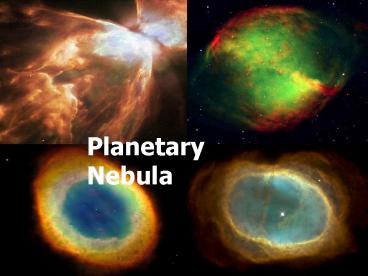Planetary Nebula - PowerPoint PPT Presentation
1 / 19
Title:
Planetary Nebula
Description:
Krypton Calcium Lithium. Analyzed Emission Lines. Krypton Calcium Lithium ... Krypton (emission) Lithium (emission) Hydrogen (absorption) Helium (absorption) ... – PowerPoint PPT presentation
Number of Views:254
Avg rating:3.0/5.0
Title: Planetary Nebula
1
Planetary Nebula
2
What Are Planetary Nebulae?
- End result of M- low F stars (little less then
1 to about 8 solar masses) - Others form supernovae
- How do these nebulae form?
- Have nothing to do with planets
- Studying planetary nebulae gives astronomers
insight into what elements originally formed the
star.
3
Our Data
- Two main areas of study Spectroscopy and
Digital Images - Spectroscopy Determines chemical makeup,
temperature and density. - Images Ultimately provides a correlation between
spectroscopy data and outward appearance - Our goal was to analyze the spectrum of two known
planetary nebulae to determine their chemical
makeup
4
Bug Nebula Spectrum
Absorption Line
Emission Line
5
Absorption Lines of Bug Nebula
Hydrogen
Helium
Sulfur
6
Analyzed Absorption Lines
Hydrogen Helium Sulfur
7
Emission Lines of Bug Nebula
Oxygen Sodium Nitrogen Neon
8
Analyzed Emission Lines
Oxygen Sodium Nitrogen Neon
9
Absorption Lines of Southern Ring (Eight Burst)
Nebula
Southern Ring
Bug
Hydrogen Helium Sulfur
10
Analyzed Absorption Lines
Hydrogen Helium Sulfur
11
Southern Ring Emission Lines
Krypton Calcium Lithium
12
Analyzed Emission Lines
Krypton Calcium Lithium
13
Kirchhoff's Laws
- According Kirchhoff's laws, the light produced by
a planetary nebula should be an emission
spectrum, with spikes of emission at specific
wavelengths corresponding to the elements in the
gas.
14
Kirchhoff's Laws
- A planetary nebula has the light source
completely surrounded by the gas, meaning we see
the same thing from every direction and thus see
absorption and emission lines
15
- Southern Ring Nebula
- Calcium (emission)
- Krypton (emission)
- Lithium (emission)
- Hydrogen (absorption)
- Helium (absorption)
- Sulfur (absorption)
- Bug Nebula
- Oxygen (emission)
- Sodium (emission)
- Nitrogen (emission)
- Neon (emission)
- Hydrogen (absorption)
- Helium (absorption)
- Sulfur (absorption)
16
Similarities and Differences
- We can hypothesize that there may be a similar
pattern in the absorption lines of most planetary
nebulae, specifically regarding the balmer lines
of hydrogen, helium, and sulfur. - The emission lines, we believe are dependent on
the age of the nebula and the size and
temperature of the central star.
17
Bug Nebula (Faulkes Telescope South)
18
Southern Ring Nebula (Hubble Space Telescope)
19
Sources
Planetary Nebula http//FusEdWeb.llnl.gov/CPEP/ h
ttp//hubblesite.org/newscenter/archive/releases/1
998/39/image/a/ http//www.astro.washington.edu/la
bs/clearinghouse/labs/ProppnShort/proppn.html Ide
ntifying elements from spectra http//www.astro.w
ashington.edu/labs/clearinghouse/labs/Spectanalysi
s/images/compspec.jpg Emission/Absorption
lines http//www.astro.cornell.edu/academics/cour
ses/astro201/kirchhoff.htm Southern Ring
Nebula http//hubblesite.org/newscenter/archive/r
eleases/1998/39/image/a/ http//www.nasa.gov/multi
media/imagegallery/image_feature_443.html General
http//simbad.u-strasbg.fr/simbad/sim-fid http/
/skyview.gsfc.nasa.gov/cgi-bin/query.pl












![[OIII] Observations of Six Planetary Nebulae PowerPoint PPT Presentation](https://s3.amazonaws.com/images.powershow.com/7077550.th0.jpg?_=20150823071)


















